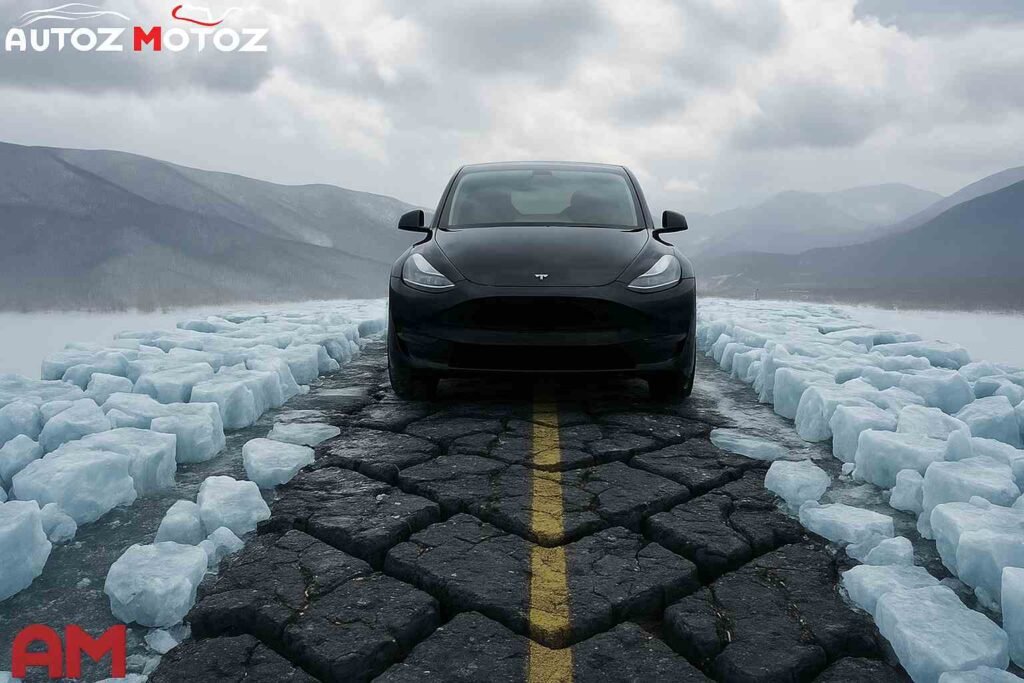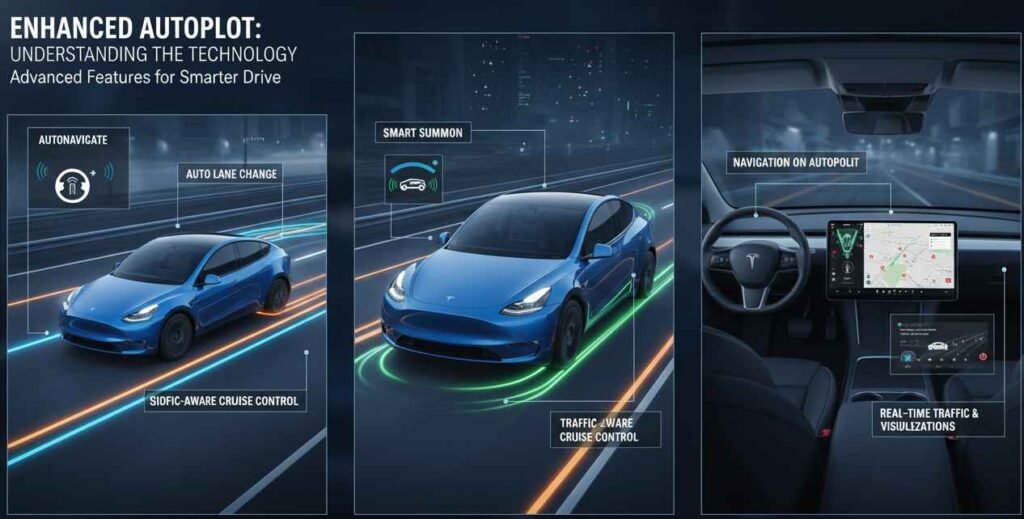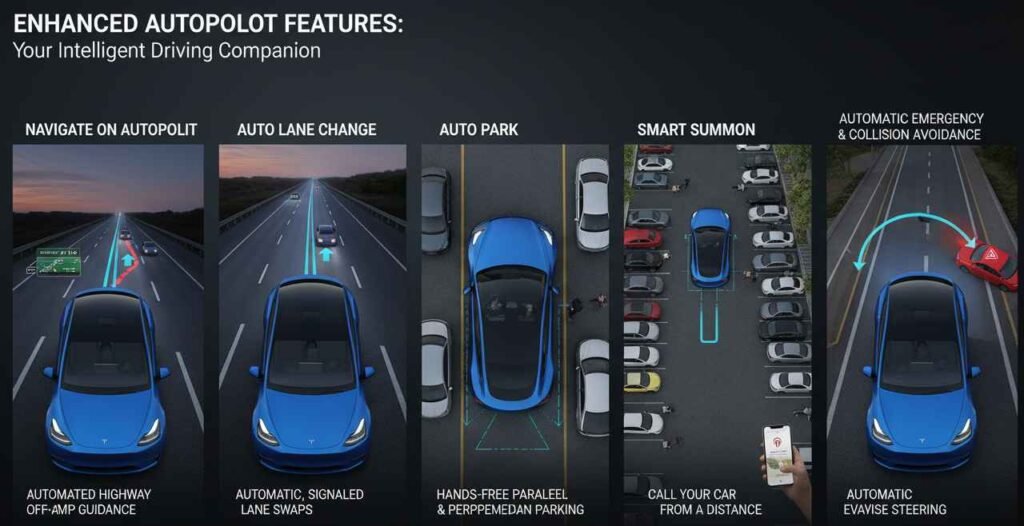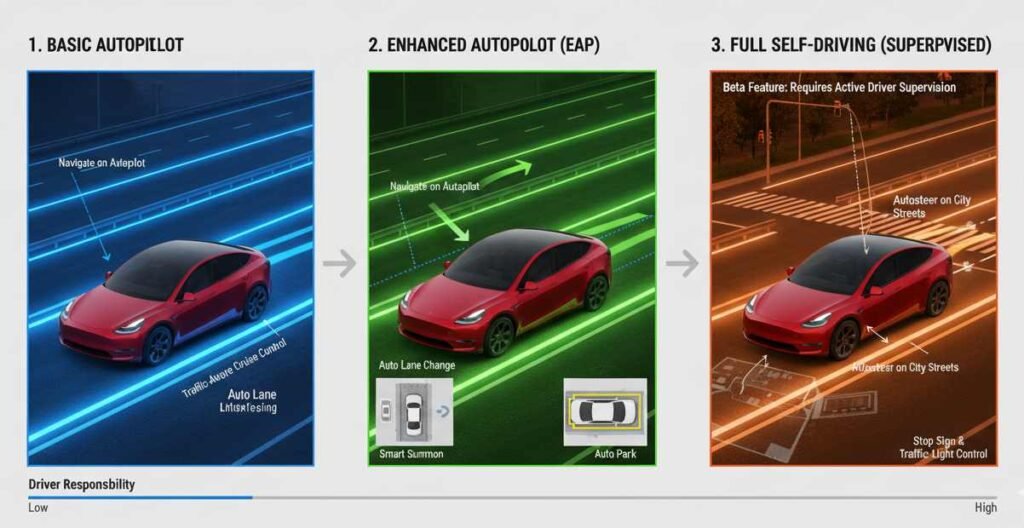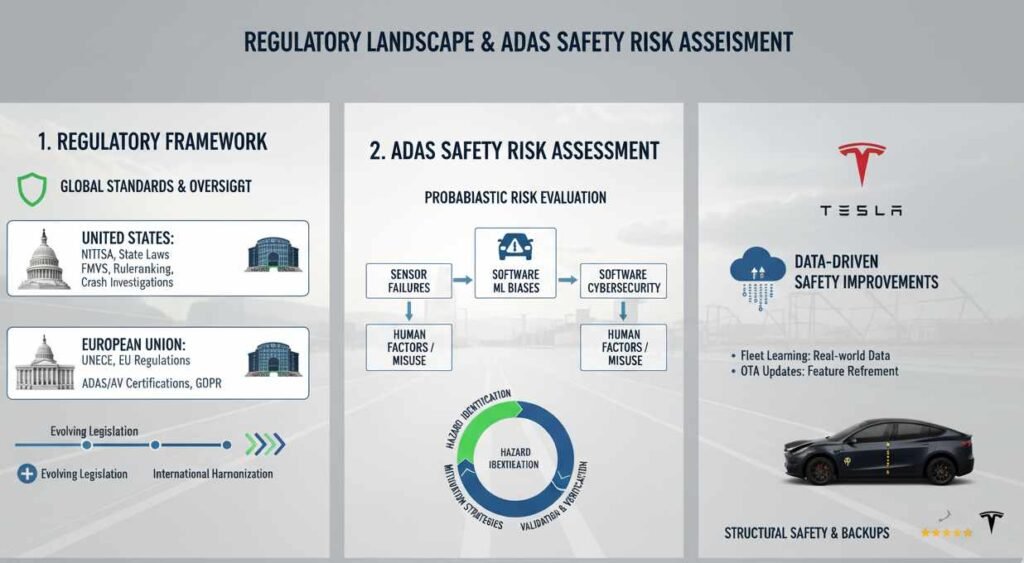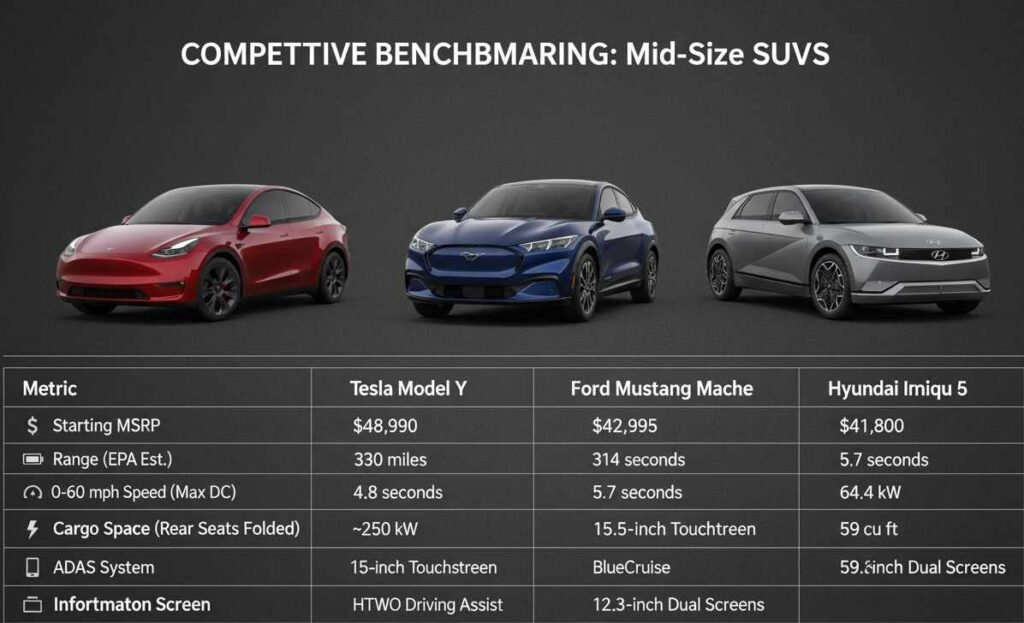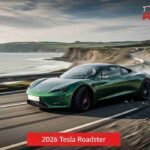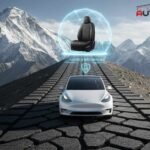This guide explores everything you need to know about Enhanced Autopilot for the Tesla Model Y in 2026, including technical specifications, market insights, features, safety considerations, and strategic recommendations.
“You know a factory is advanced if it feels like an alien dreadnought landed.”
TABLE OF CONTENT
What is Enhanced Autopilot? Understanding the Technology
Core philosophy
Evolution and AI improvements
Enhanced Autopilot Features: Your Intelligent Driving Companion
Navigate on Autopilot
Auto Lane Change
Autopark
Automatic Emergency Steering and Collision Avoidance
Tesla Model Y: Technical Specifications and Market Variants (2026)
Performance, range, and powertrain metrics (include tables)
Pricing, value fluctuation, and Juniper refresh
The Tesla ADAS Ecosystem: Differentiation and Availability
Basic Autopilot
Enhanced Autopilot feature deep dive
Full Self-Driving (Supervised) distinction
Cost Analysis and Total Cost of Ownership
Acquisition economics (one-time purchase vs subscription)
Reliability and maintenance considerations
Supercharger network economics
Regulatory Landscape and ADAS Safety Risk Assessment
NHTSA investigations
Legal liability and precedent
Competitive Benchmarking and Value Proposition
Performance, range, charging, ergonomics, and build quality
Comparison with Ford Mustang Mach-E and Hyundai Ioniq 5
Guidance on Autopilot tier selection
Quality assurance and future-proofing
Investment and practical considerations
Conclusion: Making Your Decision
Recap of practical benefits and technological value
Encouragement for informed adoption of Enhanced Autopilot
Related : Top 40 car brands and subsidiaries
Related : Why tesla model Y is cheap ?
Welcome to the Future of Driving
Imagine a world where your daily commute transforms from a stressful obligation into a relaxing journey. Where highway lane changes happen seamlessly, parking becomes effortless, and your vehicle anticipates traffic patterns before you even notice them. This isn’t science fiction—this is the reality that Enhanced Autopilot Tesla Model Y brings in 2026.
The Tesla Model Y has revolutionized the electric SUV market, combining spacious versatility with cutting-edge technology. At the heart of this technological marvel lies Enhanced Autopilot (EAP), a sophisticated driver assistance system bridging basic Autopilot features and the premium Full Self-Driving (FSD) package. For drivers seeking an elevated driving experience without committing to full autonomy, EAP offers convenience, safety, and futuristic capabilities.
What is Enhanced Autopilot? Understanding the Technology
Enhanced Autopilot (EAP) represents Tesla’s intermediate tier of autonomous driving assistance. It’s positioned between the standard Autopilot features and the comprehensive Full Self-Driving package. Think of it as the “Goldilocks” option—not too basic, not too advanced, but just right for drivers who want substantial autonomous capabilities at a reasonable cost.
Core Philosophy
Tesla’s approach to EAP focuses on reducing driver workload while maintaining safety and control. The system serves as an intelligent co-pilot, handling repetitive, predictable driving tasks. This reduces fatigue, allowing drivers to arrive at destinations more focused and relaxed.
Evolution and Innovation
Model Y features advanced sensors, improved algorithms, and AI enhancements, significantly increasing autonomous driving capabilities. Over-the-air software updates continuously refine EAP, a unique advantage over traditional automakers.
Enhanced Autopilot Features: Your Intelligent Driving Companion
Navigate on Autopilot
Navigate on Autopilot guides your Model Y from highway on-ramp to off-ramp, optimizing lane position, speed, and route based on traffic flow, interchanges, and nearby vehicles. It anticipates road conditions and adjusts smoothly, handling complex highway scenarios safely and efficiently.
Auto Lane Change
Auto Lane Change allows the vehicle to shift lanes automatically when the driver confirms via the turn signal. The system evaluates gaps in traffic, blind spots, and surrounding vehicle behavior, executing lane changes safely while providing a feeling of an experienced co-pilot.
Autopark
Autopark handles parallel and perpendicular parking with precision, using sensors and cameras to navigate tight spaces. It adjusts steering, acceleration, and braking, positioning the vehicle optimally while accounting for curbs, obstacles, and surrounding cars.
Summon & Smart Summon
Summon moves the vehicle independently short distances, perfect for tight garages or crowded spaces. Smart Summon navigates complex parking lots to reach your location, avoiding pedestrians and obstacles—ideal for heavy shopping or mobility challenges.
Automatic Emergency Steering and Collision Avoidance
EAP continuously monitors surroundings for imminent collisions. If necessary, the system intervenes through emergency steering and automatic braking, prioritizing safety in forward, lateral, and diagonal directions.
“We are building our own battery cells, what we think is the most advanced cell in the world, at Giga Texas. We think this will become the biggest cell factory in the world.”
Tesla Model Y: Technical Specifications and Market Variants
Performance, Range, and Powertrain Metrics
| Trim/Powertrain | 0-60 mph (sec.) | EPA Range (miles) | WLTP Range (miles) | Max DC Charge (kW) |
|---|---|---|---|---|
| RWD (Standard) | 5.3 | 244 | 282 | 175 |
| Long Range AWD (Current) | 4.8 | 311 | 331 | 175 |
| Performance (Pre-Juniper) | 3.5 | 277 | 319 | 175 |
| Long Range AWD (Juniper) | 4.1 | N/A | 353 | 250 |
The Model Y offers impressive acceleration and charging capabilities. The Juniper refresh (2025-2026) adds hardware and comfort upgrades including ventilated seats, 8-inch rear touchscreen, and second-generation suspension, improving range and interior experience.
Pricing and Market Dynamics
North America: Base RWD around $40,000, affected by expiration of federal EV tax credits.
Europe: Base RWD ~€44,990 (Germany).
Third-party customization: $4,995–$5,395.
The Juniper refresh sets a new technological standard, accelerating depreciation for pre-Juniper models.
The Tesla ADAS Ecosystem: Differentiation and Availability
1. Basic Autopilot:
Included as standard in all Tesla models, Basic Autopilot offers Traffic-Aware Cruise Control and Autosteer functions. It provides Level 2 driver assistance, maintaining speed and lane positioning. Though stable and widely available, its limited feature set serves as Tesla’s foundation for safety-focused automation, requiring full driver attention and supervision.
2. Enhanced Autopilot (EAP)
Enhanced Autopilot adds Navigate on Autopilot, Auto Lane Change, Autopark, and Smart Summon for highway and parking convenience. In 2026, Tesla is expanding EAP availability across more markets with improved environmental perception and smoother maneuvering. However, geographic restrictions persist, and the system still demands constant driver oversight for safety compliance.
3. Full Self-Driving (Supervised)
FSD (Supervised) extends EAP’s capabilities by introducing Autosteer on City Streets, recognizing traffic signals, intersections, and turns.
In 2026, it remains classified as Level 2 autonomy, under strict NHTSA monitoring. Subscription ($99/month) or purchase ($8,000) options continue, though regulatory scrutiny and liability risks necessitate cautious adoption until further safety validation.
| Feature Tier | Core Functionality | Key EAP Features | One-Time Purchase (FSD) | Subscription (Upgrade to FSD) |
|---|---|---|---|---|
| Basic AP | Traffic-Aware Cruise Control, Autosteer | N/A | N/A | N/A |
| Enhanced AP | All Basic AP + convenience automation | Navigate on AP, Auto Lane Change, Autopark, Summon | N/A | $99/month |
| FSD | All EAP + City Street Autosteer | Autosteer on city streets | $8,000 | $99/month |
Cost Analysis and Total Cost of Ownership
Full Self-Driving Purchase: $8,000 one-time or $99/month subscription.
TCO Considerations: Reliability issues (panel gaps, software glitches) may increase maintenance costs.
Supercharger Network: Peak charging up to 250 kW, with congestion fees in busy locations.
Tesla’s Full Self-Driving (Supervised) package commands a premium—either a one-time $8,000 purchase or a flexible $99 monthly subscription. While this offers advanced automation and future-ready convenience, owners must weigh the long-term economics. Persistent reliability challenges—such as panel misalignments, touchscreen freezes, and intermittent software faults—can elevate maintenance costs beyond initial projections. Energy costs also vary sharply: home charging remains affordable, but public Supercharger sessions incur higher tariffs and time-based congestion fees, particularly at high-traffic sites. Although the 250 kW peak charging rate delivers superior convenience, maximizing TCO efficiency ultimately depends on charging discipline, firmware stability, and ownership duration.
Regulatory Landscape and ADAS Safety Risk Assessment
🧩 NHTSA Investigations
The NHTSA continues to investigate Tesla’s Enhanced Autopilot following multiple incidents involving driver-assist misuse and crash reports. These inquiries focus on system response time, driver monitoring reliability, and software updates. While Tesla cooperates with regulators, results will influence future safety standards for semi-autonomous driving across the EV industry.
NHTSA investigations focus on red-light and opposing lane incidents.
58 incidents cited, including 14 fires.
Legal precedent: Tesla found partially liable in wrongful death cases.
Buyers must understand limitations and ensure proper supervision.
⚖️ Legal Liability and Precedent
Legal debates around Tesla’s Enhanced Autopilot highlight shared accountability between drivers and manufacturers. Courts increasingly assess whether “driver assistance” claims create misleading expectations of autonomy. Emerging case precedents may redefine liability for semi-autonomous vehicles, influencing insurance models, consumer protection laws, and ethical AI deployment across global transportation systems.
Competitive Benchmarking
The Tesla Model Y leads in acceleration (0–60 mph in 3.5 seconds) and charging efficiency (up to 250 kW) but faces scrutiny for build quality and ADAS safety risks. The Ford Mustang Mach-E balances performance and driver engagement, offering premium interiors and superior reliability. Meanwhile, the Hyundai Ioniq 5 delivers cutting-edge 800-V charging architecture (up to 350 kW), standout design, and comfort-focused refinement. Overall, Model Y dominates infrastructure and speed; Mach-E excels in tactile control and usability; Ioniq 5 leads in next-generation efficiency and innovation. Each represents a distinct balance of performance, comfort, and technological maturity within the electric SUV segment.
| Metric | Tesla Model Y | Ford Mustang Mach-E | Hyundai Ioniq 5 |
|---|---|---|---|
| 0-60 mph | ~3.5 sec | ~3.5 sec (GT) | ~3.0 sec (N) |
| Max DC Charging | Up to 250 kW | Up to 150 kW | Up to 350 kW |
| Reliability (CR) | 2/5 (Below Avg) | Higher | Higher |
| Cabin Experience | Minimalist, single screen | Premium, physical controls | Comfort-focused, retro |
| ADAS Safety/Liability | High regulatory scrutiny | Lower profile | Lower profile |
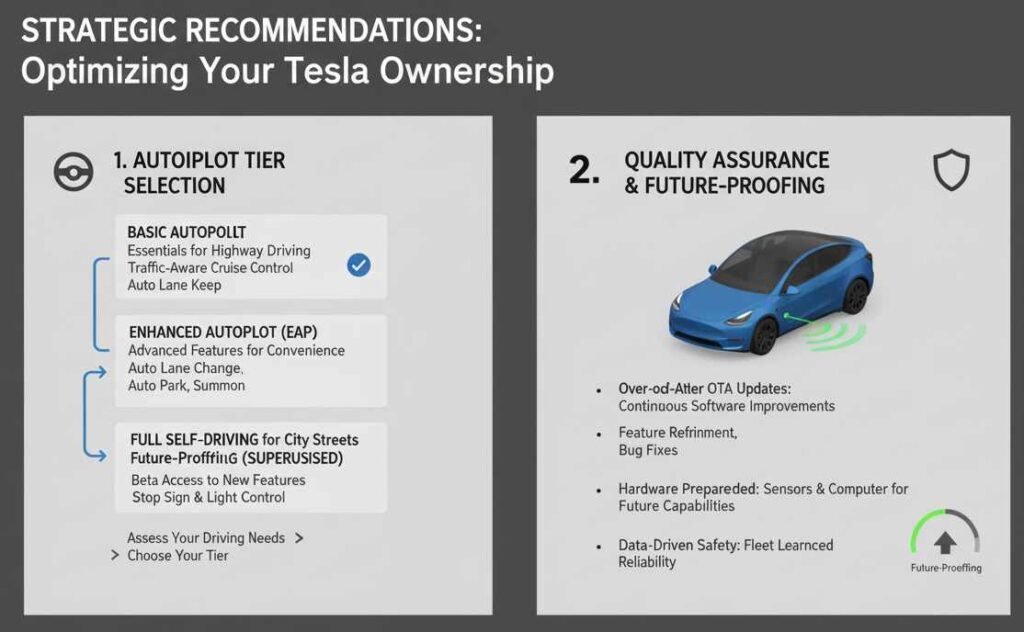
Also Read : Motorcycle Handlebar Speaker – Top notch
Strategic Recommendations
Autopilot Tier Selection
Risk-averse: Use Basic Autopilot only.
Advanced convenience: Subscribe to FSD ($99/month) rather than $8,000 upfront.
Quality Assurance and Future-Proofing
Pre-delivery inspections recommended for panel gaps, electronics, and paint.
Prefer Juniper refresh for long-term value and latest features.
“By 2026, strategic buyers of the Tesla Model Y should prioritize the Juniper-refresh edition to benefit from upgraded suspension, enhanced cabin comfort, and refined ADAS reliability. Avoid full capital commitment to Full Self-Driving (Supervised) amid ongoing NHTSA investigations and expanding legal liability (see The Guardian, 2025; Electrek, 2025). Instead, adopt the $99/month subscription model for operational flexibility. Rigorous pre-delivery inspections remain essential to mitigate the vehicle’s known reliability deficits (source: Consumer Reports, 2025). As Supercharger access becomes increasingly shared, long-term competitiveness will rely on software efficiency and ownership experience, ensuring regulatory compliance and sustained ROI through 2026 and beyond.”
Related : Why tesla model Y is cheap ?
Conclusion: Making Your Decision
Enhanced Autopilot for the Tesla Model Y delivers substantial technological and practical benefits. It eases commuting stress, improves highway safety, and enhances parking and navigation convenience. Buyers should balance personal driving habits, regulatory awareness, and reliability considerations before investing in EAP or FSD.
The Tesla Model Y remains a leading electric SUV in 2025. With Enhanced Autopilot, your driving experience becomes smarter, safer, and more futuristic—positioning you at the forefront of automotive innovation.
The future of driving is here. Are you ready to embrace it with Enhanced Autopilot Tesla Model Y?
FAQ Section
❓ What is Enhanced Autopilot on Tesla Model Y?
Enhanced Autopilot is Tesla’s advanced driver-assist package offering automated lane changes, highway navigation, and self-parking. It’s a step between Basic Autopilot and Full Self-Driving (FSD).
❓ How is Enhanced Autopilot different from Full Self-Driving?
Enhanced Autopilot handles highway driving and parking, while FSD adds city-street navigation, traffic-light control, and more automation. FSD also costs more and updates via subscription.
❓ Is Enhanced Autopilot worth it for the Tesla Model Y?
For frequent highway drivers, Enhanced Autopilot offers strong value — it reduces fatigue and boosts safety. If you mostly drive in cities, you might wait for broader FSD features.
❓ Can I add Enhanced Autopilot after buying my Model Y?
Yes. Owners can purchase or subscribe to Enhanced Autopilot directly from the Tesla app. Activation occurs over-the-air once payment is complete.
❓ Does Enhanced Autopilot affect insurance or resale value?
Many insurers see safety benefits, and buyers often prefer cars with Enhanced Autopilot, potentially improving resale value — though costs vary by market.
Tech innovator and business strategist with a foundation in Computer Science and diverse expertise in IT, marketing, and banking. Committed to building disruptive products and customer experiences that shape industries and create global market dominance.

